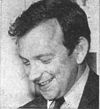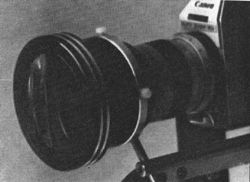

![]()
|
Tony Shapps
|
 |
A RECENT SPATE of letters from readers have all asked what amounts to the same question. It goes something like this:
"You write a lot about widescreen, yet I understand that I cannot use it because I have an XXXX-type camera fitted with a zoom lens. What advice can you give me.
Well it's not strictly true that you cannot use widescreen with a zoom lens. To be more accurate, it has usually been necessary to accept a certain amount of restriction in the range of the zoom at the wide-angle end of its travel. The reason for this is that at this end the angle 'seen' by the camera lens itself is wider than the front of the additional ,squeeze' unit that has been put in front of it.
In my little booklet, All About Widescreen, I devoted quite a lengthy section to this and other similar questions and there the matter rested until I recently carried out some additional research into the matter. So let's look at the problem and see just how I have tackled it.
My first action was to take a close look at what the professionals are doing, and what they have done in the past. I discovered several interesting things.
Firstly, it is very rare for a professional to utilise an 'add-on' anamorphic (hereafter called A-lens); they prefer to have combined, or compound, A-units for each focal length that they are using. Take the newest of the anamorphic systems, Todd-AO 35; this offers a range of compound anamorphic units that are complete in themselves (this also applies to Panavision and CinemaScope).
More recently we have seen developed a zoom-anamorphic which is, again, a compound unit. Canon's version of this also features a macro-section as well. You may also remember my recent reference to my visit to Paris to see M Bormerot and his compound Totalvision zoom/anamorphic.
Now having considered all these, it occurred to me that although we have been asserting for some years that it was impossible to use much of the zoom range with A-units, here were the professionals doing just that! Was the reason for their apparent success that they had more money than a mere amateur to play with ? I doubted it, because my own experience of the technical side of professional movie making is that they just don't like to spend on this type of thing.
Of course, I'm not saying that it could be done for nothing, but at that stage I did start to see some possibilities. My initial thoughts lead me to believe that it was necessary to have the rear element of the A-lens at least as large as that of the camera zoom lens and for some time I did work along these lines. However, closer examination of various professional lenses convinced me that there was far more involved than just making a larger rear element - even if I could get one made to fit some of the larger camera front elements!
At this point I feel that I might have been forgiven for shelving the whole operation, but so numerous had become the pleas for help that I looked for some other way of achieving the required result. And here I must take my hat off to my tame lens maker for coming up with the goods. For it became apparent that any cut-off I was getting on the zoom range was not from the rear element at all. Indeed, in most cases this had very little effect except to act as an additional camera iris on some models. The problem lay in the front element.
Back to my lens maker! I got him to cast an element 80mm in diameter for my experiments, and this went a long way to solving the problem.
Now remember that in all these experiments we are referring to cylindrically ground elements and not to the ordinary type generally used in cameras. There are very few optical companies in this country that will even look at this type of work, let alone 2. actually co-operate with someone like myself for a 'one-off' effort that might or might not be a success.
In fact, we actually made three of the first 80mm elements for fear that one might break in the grinding and polishing. I won't tell you what they cost (mainly because my wife sometimes takes a look at this column) but I can say that it is not something I'd wish to lay out money on every day. However, with these first elements we were reasonably lucky and ended up with two out of the three being usable.
The end result was that I have been able to design a number of individual units for cameras having quite large zoom ranges, and have kept the cut-off at the wide-angle end down to a bare minimum.
Among my successes have been an Elmo 8TL where there was virtually no cut-off from 7mm through to 64mm, a number of Canon 814s (for export as well, which was not only good for Tony Shapps but also for Britain!) and some Eumigs and Bauers.
 |
A typical example of a specially designed large anamorphic that gives a widescreen format of 2:1 (from an expansion factor of 1.5x). Cut-off at the wide-angle end of the zoom starts at between 8 and 9mm on this model. |
But to get back to the original question, when asked for advice on fitting anamorphics to zoom lenses I can now
answer as follows:
1. If your camera is fitted with a moderate range zoom there is a good chance that you will be
able to use a zoom lens in conjunction with an A-lens. You will have to accept some cut-off or limitation of the
range of the zoom at the wide angle end if you purchase one of the
many available ready-made units.
2. When using widescreen this cut-off is not usually too serious and, at the most, will prevent you using about a third
of the effective zoom range if your zoom goes down to 8 or 9mm, but somewhat less if you have one that starts at
around 10 or 11mm.
3. Even when you lose part of the zoom range after having got yourself an A-unit you must remember that the actual A-unit itself will compensate for this, to some extent, by
increasing the field of view of the horizontal plane. For instance, an A-lens that gives a 2:1 screen format (from a 1 -
5x compression) will make a setting of 15mm on the camera lens equivalent to a 10mm
setting - horizontally.
4. If you are prepared to have a special unit designed for your own particular camera you can do better than this -
in many cases far better. But you get what you pay for, and the really big A-unit will obviously cost more money
than the ready-to-use type.
Is it all worth it ? In my opinion the answer cannot be anything else but yes; because once you have seen widescreen in your own home it becomes difficult to live without it.
I was delighted to receive from my very good friend and fellow widescreen Association member, Mervyn Richards, a little sample of a new CinemaScope viewfinder that he has just put on the market. Mervyn, better known to nine- fivers as the go-ahead proprietor of Nine-Five Film Services, Truro, has obviously given the problem of widescreen viewfinders some considerable thought and has come up with an ingenious solution in the form of an add-on unit that sits on top of the camera and allows you to view either in full 'scope or widescreen.
The unit is nicely finished in grey and helps to solve one of the other problems of going into widescreen. Mervyn reckons that it can be fitted in 'one-minute' to such cameras as the Path6 Prince, H and National 11 9-5 cameras, but I feel that he is being a little optimistic. For my part I think that it would take just a little longer. However, it is an excellent idea and I would like to thank him on behalf of other widescreeners.
![]()
This page was last updated 02 Dec 2002